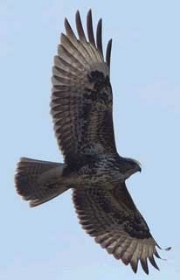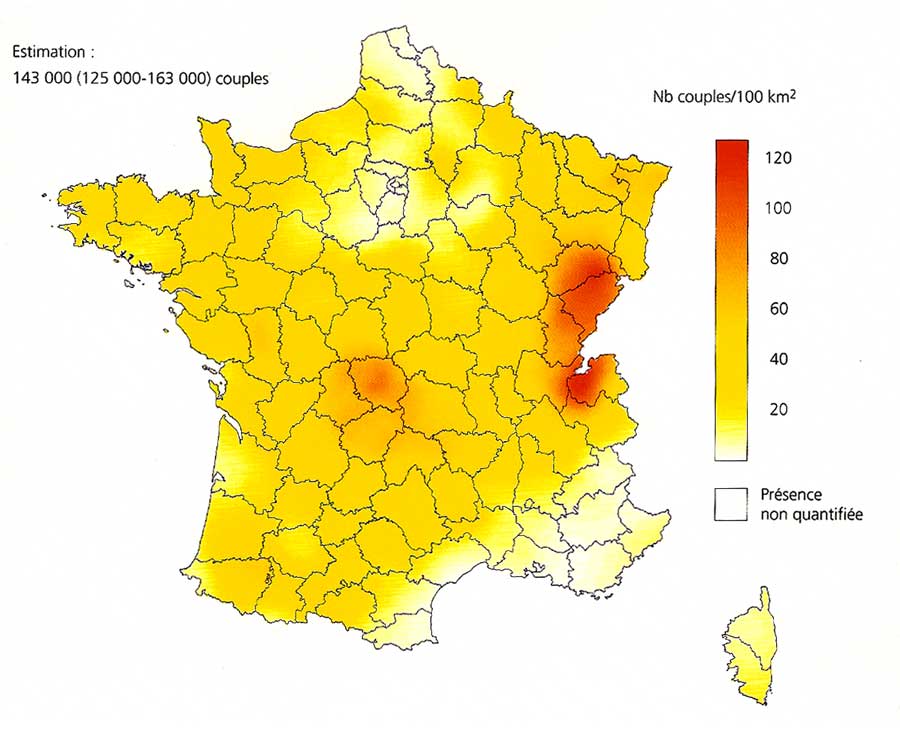Common Buzzard France



Common Buzzard Buteo buteo Buse variable
Overview.
The Common
Buzzard is by far the commonest Bird of Prey that can be easily seen by
everyone in
Appearance.
It
is not without good reason that its common name in French is Buse variable!
Juvenile birds in the first year can be almost white with bold chestnut
brown splashes on the back, wing uppers and tail, with the under parts and
under wing lightly flecked with brown or grey. During the first four years
the markings and colouration progressively change, the back, breast and wing
uppers become darker, as do the leading and trailing edges of the under
wings. In around the second year a single wide dark band develops at the
extremity of the tail which is short and wide. The extreme variation in
colour and markings cannot be over emphasised, they range from almost
totally white, through browns to almost totally black with, it would seem,
all imaginable combinations of these colours possible.

Young birds have
grey eyes but these quickly change to a brownish yellow. The cere, which is
located where the beak joins the head and contains the nostrils, is yellow,
as are the legs and talons. The beak itself is hooked and coloured black,
the neck is short and the head round.
The wings are broad
with rounded ends - see diagram above for under-wing markings.
They are typically
between 51-57 cm in length with a 110 to 130 cm wingspan.
Females weigh 700
to 1200 g and Males 550 to 850 g
The overall
impression is of a stout, compact bird.
Behaviour,
habitat and diet.
The Common Buzzard
can be found anywhere that there are both trees and open spaces. This can be
large woodlands or where trees are scattered such as in agricultural zones,
from low altitudes to mountains, but there is always a requirement for open
spaces.
They are both flexible in what they will eat and
the method of capture. The bulk of their diet is small mammals, mice and
voles, which are caught on the ground, (Hence: German – Mäusebussard or
Mouse Buzzard and Spanish - Ratonero or Mouse eater.). However they also
take birds, reptiles, batrachians, insects, slugs and earth worms. Small
quantities of cereals and carrion will sometimes be eaten when other food is
in short supply and there is some evidence that they will occasionally take
smaller poultry. They are particularly well known for their method of
catching moles by watching for the soil to move, when they then pounce from
their perch. They also locate prey by listening for movements in grass. Like
many other raptors they use their binocular vision to locate prey when
gliding at around at an altitude of 100 metres or so.

In the southern
and western regions of
Breeding and
Reproduction.
As early as January
couples will choose a new nest site high in a large tree or a ledge on a
rock face, (still within their territory), and start to intensify their
defence of it. The nest is constructed using twigs and small braches; then
lined with leaves and grasses. At the same time ritual bonding flights or
“displays” take place where the pair climb high into the sky together making
passes, turns and dives.
The female lays 1
to 4 eggs at intervals of 3 or 4 days and it is the female that spends most
of the time with the eggs and young, the male only replaces her
occasionally. He spends his time hunting for food and defending the nest
from interference. Incubation takes about 35 days until the last chick
hatches. Initially prey that is brought to the nest is torn into small
pieces before being feed to the young, then when they are about a month old
they are given whole prey to shred themselves. Often the last born fails to
get its fair share and ends up being trampled to death by the others. Even
when the young birds fledge they remain dependent on their parents to
provide food for a month or two. Breeding starts in the third year.
The average life
span is 12 years with a record of 28 years 9 months in

Status, threats and menaces.
There are no really serious threats these days for the Common Buzzard
although a certain amount of persecution still continues illegally this
hardly constitutes a “serious problem” and is more a hangover from the past
with a small number of “hunters”. Many Buzzards that appear to have died in
a healthy condition will show evidence of shot gun pellets when x-rayed or
will have been poisoned. Population will vary according to the number of
voles available and in poor years some will move out of the area.
Status - Fully protected species.

